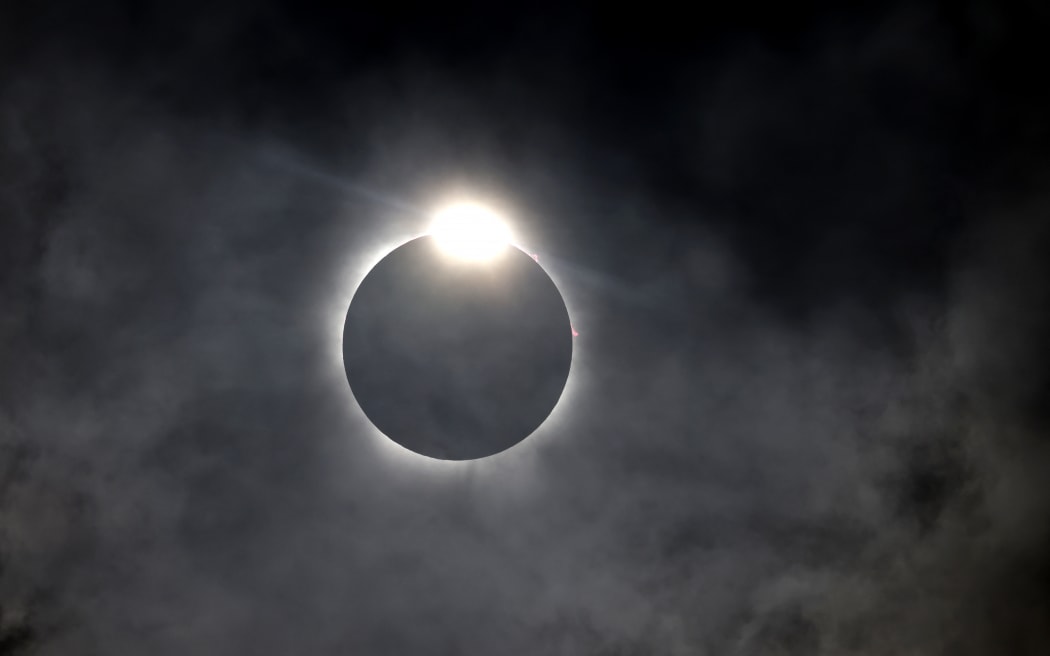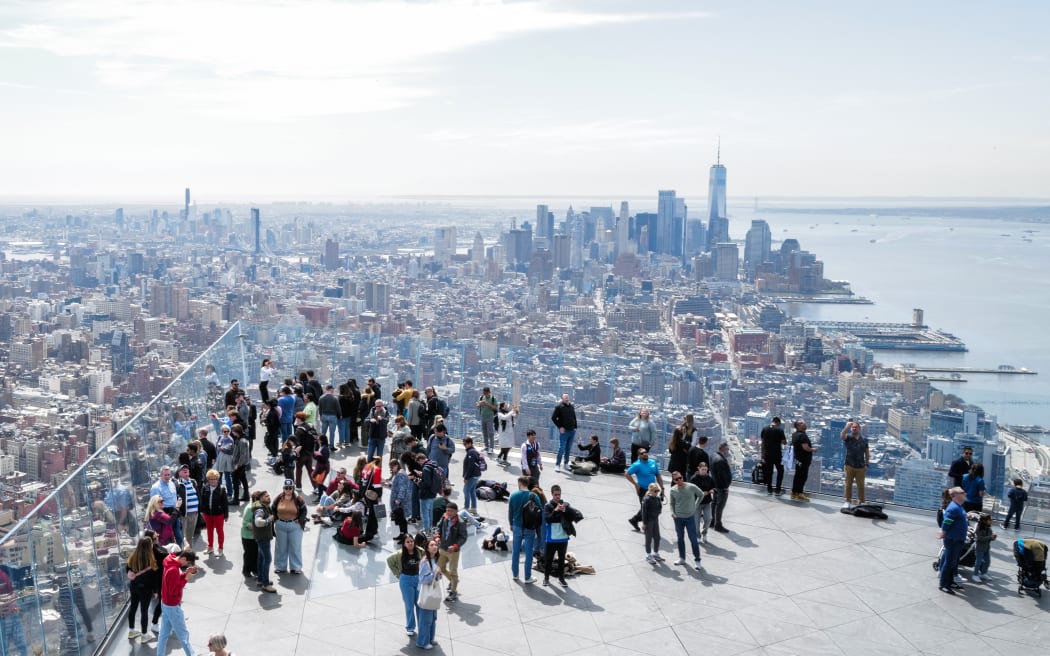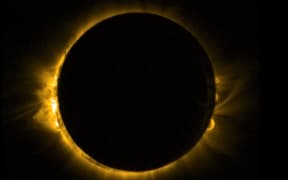By Henry Romero, Joseph Ax and Brad Brooks, Reuters
The first total solar eclipse to grace North America in seven years made landfall in Mexico on Tuesday (NZT) as millions of skywatchers gazed upward for the start of a celestial display at least partially visible, weather permitting, across most of the continent.
The Mexican beachside resort town of Mazatlan was the first major viewing spot along the "path of totality" in North America. Thousands of people gathered along the coastal promenade, setting themselves up in deck chairs with solar-safe eyewear as an orchestra played the "Star Wars" movie theme. The crowds burst into cheers and applause and the eclipse reached totality.
Where clear skies prevail, observers along the direct path of the eclipse were being treated to the rare spectacle of the moon appearing as a dark orb creeping in front of the sun, briefly blocking out all but a brilliant halo of light, or corona, around, the sun's outer edge.
The period of totality, lasting up to 4.5 minutes depending the observer's location, was ushered in by a number of other eerie eclipse effects. A partial eclipse, in which the moon obscures only a portion of the sun, was unfolding across most of the continental United States.
At Mazatlan, Lourdes Corro, 43, traveled 10 hours by car to get there.

Photo: AFP/Getty Images
"The last one I saw was when I was 9 years old," Corro said. "There are a few clouds but we can still see the sun."
Eclipse fans are gathering in numerous places along the "path of totality," which stretches from Mexico's Pacific Coast through Texas and across 14 other US states into Canada.
At the Frontier Town campground in North Hudson, New York, children ran around wearing eclipse T-shirts, while parents set up tables, chairs and beer coolers.
Connecticut residents Bob and Teresa Love were stretched out in the cargo bed of their pickup truck, eating pastries and hoping the forecasted clouds hold off long enough to see the show.
"I'm trying not to get too excited because of weather, just trying to keep expectations real," said Teresa, 49. "Some people say it's life-changing. I don't know if it's going to be life-changing, but I think it's going to be cool to see."

People gather on the 'Edge at Hudson Yards' observation deck in New York City ahead of a total solar eclipse across North America. Photo: AFP
Michael Zeiler, a veteran eclipse chaser from New Mexico who already has witnessed 11 total eclipses across the globe, planned to watch the event from the city of Fredericksburg in central Texas.
"First-time viewers of a total eclipse will be gobsmacked by the sight," said Zeiler, a cartographer and amateur astronomer who created the Great American Eclipse website. "It will be a peak life experience."
At up to 4 minutes and 28 seconds, this one will last longer than the total eclipse that streaked across parts of the United States in 2017, which clocked in at up to 2 minutes and 42 seconds. According to NASA, total eclipses can last anywhere from 10 seconds to about 7.5 minutes.

People are set up at Niagara Falls State Park ahead of a total solar eclipse across North America. Photo: AFP
Some cities along the path of totality include: Mazatlan, Mexico; San Antonio, Austin and Dallas, Texas; Indianapolis, Indiana; Cleveland, Ohio; Erie, Pennsylvania; both Niagara Falls, New York, and Niagara Falls, Ontario, site of the famed waterfall, and Montreal, Quebec.
A partial eclipse will be visible in North America outside the path of totality.
About 32 million people in the United States live within the path of totality, with federal officials predicting another 5 million people will travel to be there. Countless eclipse-watching events were being convened at bars, stadiums, fairgrounds and parks along the path of totality.
Along the main shopping street in Oswego, New York, stores were selling eclipse-themed cookies and T-shirts, while a nearby eclipse-themed stage stood ready to host bands for a block party.
This will be the ninth total eclipse for Anthony Aveni, author of the book In the Shadow of the Moon: The Science, Magic and Mystery of Solar Eclipses and a professor emeritus of physics and astronomy, sociology and anthropology at Colgate University in Hamilton, New York.
"It's an interruption in nature's status quo," Aveni said. "And it's an interruption that takes your breath away."
Experts have advised eclipse viewers to use protective solar glasses to prevent eye damage from looking at the sun with the naked eye. Only during the few minutes of totality can the sun can be safely viewed without such glasses, they said.
Overcast skies are among an eclipse-chaser's worst fears. The US National Weather Services forecast as of Monday morning was for "a rapid untimely increase of clouds" in Southern Texas; less worrying "high thin clouds" for a swathe from Arkansas to the Midwest; and the clearest skies in northern New England.
It will take about 80 minutes from the moment the moon first begins to cover the sun to the moment of totality, then another 80 minutes to complete the process in reverse.
Eclipse veterans have described the 15 minutes before totality as foreboding, with shadows becoming oddly crisp and sunshine assuming an eerie quality. In the seconds before totality, a phenomenon called "shadow bands" may appear shimmering shadows on the ground, like those seen on the bottom of a swimming pool.
The last remaining bit of brilliant sunlight before totality creates a "diamond ring effect" in which a single bright spot appears along the lunar edge even as the sun's atmosphere leaves a ring of light around the moon.
Aveni said each eclipse he has witnessed has inspired deep awe in everyone around him who saw it, igniting a sense of community. He said people frequently burst into tears and hug complete strangers.
"No matter who you are or when you lived, the sight of an eclipse begins with fear," Aveni said. "The imagery shocks you. That fear is gradually transformed into awe and then into a sublime state."
- This story was first published by Reuters.


